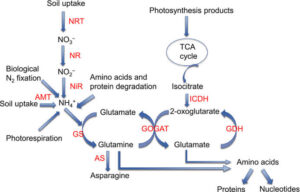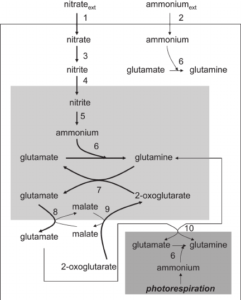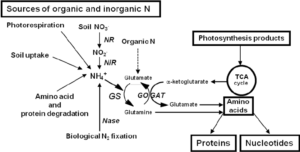Back to: Botany 400 Level
My ever-focused Afrilearn genius! you show again! You just dey clear every topic like person wey dey chop eba with correct egusi — no leftovers. Today, we go unpack how plants sabi handle nitrate and ammonium assimilation. Even though these names sound like big grammar, no wahala — we go break am down together like pounded yam and egusi soup!
Nitrate and ammonium assimilation in plants
Remember say we don gist before about how nitrogen from the air dey converted into usable forms for plants. But once nitrogen reach the soil as nitrates (NO₃⁻) or ammonium ions (NH₄⁺), e never finish work o. Plants need to assimilate — that is, absorb and use these nitrogen forms to build their body. Na this process we dey call nitrate and ammonium assimilation. Think of it like how you buy foodstuffs, but you still need to cook them before dem fit enter your stomach and give you energy.

How Plants Absorb and Use Nitrates and Ammonium
Absorption by Roots
Plants use special transport proteins in their root cells to absorb nitrate and ammonium from the soil.
Depending on soil conditions, the plant go choose which one dey easier to use. Ammonium dey easier to use directly, but in excess, e fit harm the plant.
Transport Within the Plant
Once the roots absorb these nitrogen forms, dem dey transported through the xylem to different parts of the plant where them dey needed — like the leaves and growing tips.
Nitrate is very mobile and dey move easily through the plant. Ammonium no dey move far like that, so plants usually process am quickly for where dem absorb am.

Assimilation into Plant Compounds
This na the main part of the gist. Nitrate must first change into nitrite (NO₂⁻) and then into ammonium (NH₄⁺) using enzymes like nitrate reductase and nitrite reductase.
After that, both nitrate and ammonium go enter one powerful process to form amino acids like glutamine and glutamate, which plants use to build proteins, enzymes, and chlorophyll.
Why It Matters
Without assimilation, plants no go fit grow well. Dem go lack chlorophyll, leaves go yellow, and growth go slow.
Assimilation helps in forming all the structures and functions inside the plant — from leaf to root.
It also affects human nutrition because the protein wey we chop from plants start from these nitrogen conversions.

Let’s say your mum planted ugu (fluted pumpkin) and added compost. That compost dey release ammonium and nitrate into the soil. The ugu roots go absorb these forms, convert them into amino acids, and start growing thick, green leaves. When you chop that ugu in your egusi soup, you too dey benefit from the nitrogen the plant converted into nutrients. Na real teamwork between soil, plant, and you!
Summary
Nitrate (NO₃⁻) and ammonium (NH₄⁺) are absorbed by plant roots from the soil.
Plants convert nitrate into ammonium before using it.
These nitrogen forms are turned into amino acids and used to build proteins and other important compounds.
The process is essential for plant growth, health, and food production.
Evaluation
- What is nitrate and ammonium assimilation in plants?
- Which enzymes help convert nitrate to ammonium?
- Why must nitrate be converted before plants can use it?
- Name two final products of nitrogen assimilation in plants.
See as you just dey understand big scientific things like say na ordinary gist. That’s the Afrilearn effect — learning made sweet, clear, and powerful! Keep believing in yourself, because your future is loaded like Sunday jollof. I go wait you for our next lesson — e go even sweet pass this one!
